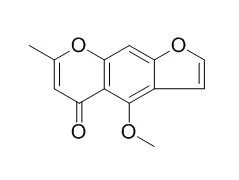| Description: |
Visnagin has acute hypotensive, anti-inflammatory, and neuroprotective effects, it protects against doxorubicin-induced cardiomyopathy through modulation of mitochondrial malate dehydrogenase. Visnagin can relax aortae previously contracted by noradrenaline, and weakly inhibit the hydrolytic activity of the cyclic nucleotide phosphodiesterase (PDE) isozymes (PDE5, PDE4, PDE3, cyclic GMP activated PDE2 and PDE1). |
| In vitro: |
| PLoS One. 2013 Sep 19;8(9):e74917. | | Khellin and visnagin differentially modulate AHR signaling and downstream CYP1A activity in human liver cells.[Pubmed: 24069365] | Khellin and Visnagin are two furanochromones that can be frequently found in ethnomedical formulations in Asia and the Middle East. Both compounds possess anti-inflammatory and analgesic properties, therefore modern medicine uses these compounds or structurally related derivatives for treatment of vitiligo, bronchial asthma and renal colics. Despite their frequent usage, the potential toxic properties of Visnagin and khellin are not well characterized up-to-now.
METHODS AND RESULTS:
The observed induction of several other members of the AHR gene battery, whose gene products are involved in regulation of cell growth, differentiation and migration, indicates that a further toxicological characterization of Visnagin and khelllin is urgently required in order to minimize potential drug-drug interactions and other toxic side-effects that may occur during therapeutic usage of these furanochromones. |
|
| In vivo: |
| Korean J Physiol Pharmacol. 2010 Oct;14(5):257-63. | | Neuroprotective Effect of Visnagin on Kainic Acid-induced Neuronal Cell Death in the Mice Hippocampus.[Pubmed: 21165322 ] | Visnagin (4-methoxy-7-methyl-5H-furo[3,2-g][1]-benzopyran-5-one), which is an active principle extracted from the fruits of Ammi visnaga, has been used as a treatment for low blood-pressure and blocked blood vessel contraction by inhibition of calcium influx into blood cells. However, the neuroprotective effect of Visnagin was not clearly known until now.
METHODS AND RESULTS:
Thus, we investigated whether Visnagin has a neuroprotective effect against kainic acid (KA)-induced neuronal cell death. In the cresyl violet staining, pre-treatment or post-treatment Visnagin (100 mg/kg, p.o. or i.p.) showed a neuroprotective effect on KA (0.1 μg) toxicity. KA-induced gliosis and proinflammatory marker (IL-1β, TNF-α, IL-6, and COX-2) inductions were also suppressed by Visnagin administration.
CONCLUSIONS:
These results suggest that Visnagin has a neuroprotective effect in terms of suppressing KA-induced pathogenesis in the brain, and that these neuroprotective effects are associated with its anti-inflammatory effects. | | Planta Med. 2000 Feb;66(1):35-9. | | Cardiovascular effects of visnagin on rats.[Pubmed: 10705731] | The present article describes the effects of Visnagin on systolic blood pressure and heart rate in the anaesthetized rat.
METHODS AND RESULTS:
Intravenous administration of Visnagin (0.3-5 mg kg-1) produced dose-related decreases in blood pressure with no significative changes in heart rate. Under nitric oxide synthase inhibition (L-NAME, 50 mg kg-1) the hypotensive effects of Visnagin (5 mg kg-1) were not affected. Visnagin (5 x 10(-6) M-10(-4) M) produced a weak decrease in the rate and amplitude of spontaneous contractions in right atria. Visnagin also caused a weak decrease in peak contractile force and the df/dtmax with no significant changes in the time to peak tension or the time for total contraction in left atria driven at a basal rate of 1 Hz. Visnagin (10(-5) M, 5 x 10(-5) M and 10(-4) M) concentration-dependently decreased pressor response to KCl (IC50 = 5.1 +/- 2.5 x 10(-5) M) and noradrenaline (IC50 = 2.6 +/- 0.9 x 10(-5) M) in rat isolated mesenteric beds. Visnagin (3 x 10(-7) M-10(-4) M) induced a concentration-dependent relaxation of isolated mesenteric arteries contracted by noradrenaline (IC50 = 1.7 +/- 0.8 x 10(-5) M). The relaxant effects in the absence of functional endothelium were not significantly different (IC50 = 1.5 +/- 0.3 x 10(-5) M, P > 0.05) from those observed in segments with intact endothelium.
CONCLUSIONS:
In conclusion, the main mechanism responsible for the acute hypotensive effect of Visnagin is the vasorelaxant response induced by this drug in resistance arteries. | | Biomed Pharmacother . 2019 Apr;112:108629. | | Visnagin attenuates acute pancreatitis via Nrf2/NFκB pathway and abrogates associated multiple organ dysfunction[Pubmed: 30798137] | | Abstract
Acute pancreatitis (AP) is an exocrine dysfunction of the pancreas where oxidative stress and inflammatory cytokines play a key role in induction and progression of the disease. Studies have demonstrated that antioxidant phytochemicals have been effective in improving pancreatitis condition, but there are no clinically approved drugs till date. Our study aims to assess the preventive activity of Visnagin, a novel phytochemical isolated from Ammi visnaga against cerulein induced AP. Male Swiss albino mice were divided into six groups (n = 6, each group) comprising of normal control, cerulein control, seven day pre-treatment with Visnagin at three dose levels; Visnagin low dose (10 mg/kg), Visnagin mid dose (30 mg/kg), Visnagin high dose (60 mg/kg) and Visnagin control (60 mg/kg). AP was induced by six injections of cerulein (50 μg/kg, i.p.) on the 7th day and the animals were sacrificed after 6 h of last cerulein dose. Various markers of pancreatic function, oxidative stress and inflammation were assessed. Visnagin was found to be effective in reducing plasma amylase and lipase levels, reduced cerulein induced oxidative stress. Visnagin dose dependently decreased the expression of IL-1β, IL-6, TNF-α and IL-17. It attenuated the levels of nuclear p65-NFκB. Visnagin improved the antioxidant defence by improving Nrf2 expression and halted pancreatic inflammation by suppressing NFκB and nitrotyrosine expression in the acinar cells. Further, it attenuated the expression of markers of multiple organ dysfunction syndrome and reduced inflammatory cytokines in lungs and intestine. Cumulatively, these findings indicate that Visnagin has substantial potential to prevent cerulein induced AP.
Keywords: Acute pancreatitis; Inflammation; NFκB; Nitrotyrosine; Nrf2; Visnagin. |
|






 Cell. 2018 Jan 11;172(1-2):249-261.e12. doi: 10.1016/j.cell.2017.12.019.IF=36.216(2019)
Cell. 2018 Jan 11;172(1-2):249-261.e12. doi: 10.1016/j.cell.2017.12.019.IF=36.216(2019) Cell Metab. 2020 Mar 3;31(3):534-548.e5. doi: 10.1016/j.cmet.2020.01.002.IF=22.415(2019)
Cell Metab. 2020 Mar 3;31(3):534-548.e5. doi: 10.1016/j.cmet.2020.01.002.IF=22.415(2019) Mol Cell. 2017 Nov 16;68(4):673-685.e6. doi: 10.1016/j.molcel.2017.10.022.IF=14.548(2019)
Mol Cell. 2017 Nov 16;68(4):673-685.e6. doi: 10.1016/j.molcel.2017.10.022.IF=14.548(2019)